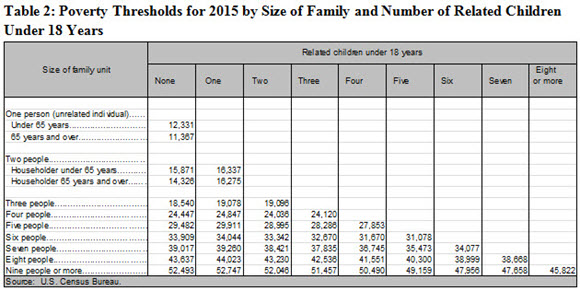"What Does it Mean to be in Poverty in the U.S., Statistically Speaking?"
"What Does it Mean to be in Poverty in the U.S., Statistically Speaking?"
You may have heard public officials or the media talk recently about the poverty rate in America. In advance of the U.S. Census Bureau’s release of its annual income and poverty reports next week, we thought it might be worth reviewing how poverty is officially defined and measured in the United States.
The official poverty measure for the United States was established in 1969 and is calculated based on data collected in the Annual Social and Economic Supplement to the Current Population Survey (CPS). The CPS is a household survey sponsored jointly by the U.S. Census Bureau and the U.S. Bureau of Labor Statistics and has data dating back to 1965 on key socio-economic topics about the population.
Two factors are used to determine a family’s or individual’s poverty status: (1) their family or individual income and (2) their poverty threshold. If a family’s total income for the year is below its assigned poverty threshold, then that family — and every individual in it — is considered to be in poverty.
It seems simple, but understanding how poverty is measured and how to interpret the resulting statistics can be confusing. Let’s start with how we define a family. The Census Bureau groups people living in a household into families based on their relationships to one another. Families consist of individuals who are related by birth, marriage or adoption. A household can consist of a single family, a single individual, multiple families, multiple unrelated people living together (such as roommates), or some combination of families and unrelated individuals (Table 1).
Once people are grouped into families within a household, the appropriate incomes are combined into a total family income measure. For an unrelated individual, their personal income is their family income. However, many people are surprised by what is and is not included in this income measure. When calculating the official poverty measure, family income is calculated from only pretax cash income. That includes things like earnings before taxes, Social Security, pensions and retirement income, cash public assistance and child support, but excludes capital gains, noncash benefits such as food assistance or housing subsidies, as well as the value of property and money saved in bank accounts.
Once total family income is calculated, poverty status is determined by comparing a family’s annual income to their assigned poverty threshold. Poverty thresholds are set by the Office of Management and Budget’s Statistical Policy Directive 14 and are updated every year for inflation. Thresholds vary by only two factors: (1) size of the family and (2) age of the family members. Thresholds do not vary geographically, meaning families of the same composition will have the same poverty threshold regardless of where they live in the United States. See Table 2 for 2015 poverty thresholds.
If a family’s total annual income is below their poverty threshold, then that family (including every individual in it) is considered to be in poverty for the year.
Measures of poverty in the United States are extremely valuable, as they provide a statistical yardstick to gauge the well-being of families and evaluate year-to-year changes in poverty for the country as a whole and for specific subgroups. It is important to understand how these estimates are produced and how those methods impact the interpretation of these statistics. The poverty thresholds used for the official poverty measure are not intended to serve as a complete description of what people and families need to live, and the pretax cash income measures may not fully capture the resources available to families to meet their living expenses.
On September 13, 2016, the Census Bureau will release the new official poverty estimates, along with estimates from the Supplemental Poverty Measure (SPM). The SPM makes alternate assumptions about the grouping of families, the assignment of poverty thresholds, and the calculation of family income. While the SPM is not the “official” source of poverty and is not used to determine eligibility for government programs, it does provide valuable information on the well-being of low-income individuals. We invite the public and data users of all levels to learn more about how the Census Bureau measures poverty in the United States.
-
Random Samplings BlogWhat is the Supplemental Poverty Measure and How Does It Differ From the Official Measure?Since the publication of the first official U.S. poverty statistics in 1964, there has been a continuing debate about the best way to measure income and poverty in the United States.
-
InfographicHow the U.S. Census Bureau Measures PovertyWe measure poverty two ways every year. The official poverty measure is based on cash resources. The supplemental poverty measure includes noncash benefits.





